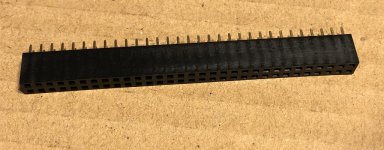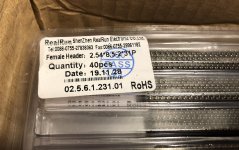Eudimorphodon
Veteran Member
Is there anyway they can do a proper double-tall male header with offset shroud like on the original RAM expansion Plus board? That way, whatever designs come out of this thread could be a proper replacement for the Plus RAM expansion allowing two more Plus boards to mount on-top.
I haven't tested this yet because I'm currently not caring a lot about cross compatibility with original boards, but my ad-hoc measurements suggest that if I were to use a "double-ended" male header (they sell trimmable 2x40s at my local shop) and shim it while soldering I could get the "low" slot to the proper .7" spacing. (If you use a normal header you end up with .5".) Likewise using a normal header for the "high" slot and plugging in a set of trimmed "extra tall" stacking headers as an extender gets you about the right height for the upper slot. So it is *possible* to cobble it together. But it certainly isn't optimal. Shrouds would also be really nice. You could probably 3d print a sleeve to fit around the suggestions above but it wouldn't be fantastic.


